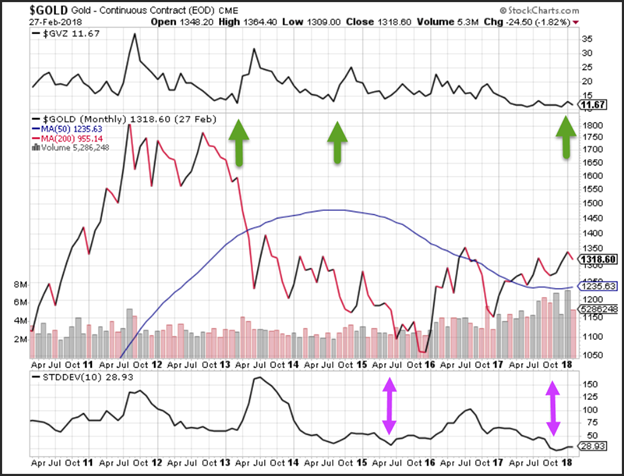
The price of gold bullion remains range-bound, and it is clear that traders do not believe that the yellow metal will experience a sharp move in the near term as reflected by the low levels of volatility. In fact, gold bar option traders are now pricing in historically low levels of premiums into gold bullion options, which means that the market displays little fear that gold bar prices will change from current levels. When complacency reaches these levels, it's time to take advantage of this situation and purchase gold coins or gold bars.
There are several ways to measure gold bullion volatility. You can measure the historical movements by calculating the historical standard deviation. You can also look at the price that option traders are willing to pay for gold bullion called options or gold put options.

Historical Volatility
The historical volatility of gold bar prices measures a distribution of the performance of gold bullion price returns and calculates how far prices have moved in the past. While the past is not a perfect predictor of future prices movements, it does tell you what happened. Since most of us are more interested in what is going to happen in the future, is important to analyze what happens next.
The chart above shows the price of gold bullion prices along with the standard deviations of gold prices and the value of gold implied volatility (which we will touch on later). What you can see is over the past 8-years the current standard deviation of gold prices has reached a period low. In fact, the last time the standard deviation of gold prices on a monthly basis reached these levels, was 2003, which was right before gold bullion prices began a 9-year rally taking the yellow metal from $300 per ounce to $1,800 per ounce.
Implied Volatility
While historical volatility tells us what happened in the future, implied volatility tells us what traders think will happen in the future. Implied volatility is a component that is used by option traders to determine the likelihood that the price of an asset will reach its strike price at some point in the future. The higher the implied volatility which is quoted as a percentage, the more likely a call option or put option will reach its strike price before expiration. Additionally, higher levels of implied volatility equate to higher premiums.
Fortunately for gold traders, there is an index produced by the Chicago Board of Options Exchange that relates the value of gold bullion implied volatility. The index GVZ is similar to the VIX volatility index. The GVZ describes the value of the implied volatility of the "at the money" strike prices for the nearby gold contracts. For example, with the price of gold at $1,330, the GVZ would tell you the implied volatility of the $1,300 call and the $1,300 put.
Where is the GVZ Now?
The GVZ is now at historically low levels. The index has been around for 8-years and is currently printing a reading of 11.67, which is just above historic lows. What that level tells us is that gold options traders do not think gold will move more than 11.67% over the next year.
In looking at prior levels when the GVZ reached historically low levels, it generally coincides with periods of consolidation just before a big move. If you have been watching gold prices recently, you are likely aware that prices have been range-bound, which is likely why both implied volatility and historical volatility are at very low levels. This phenomenon will not likely persist. It also tells us that the market has no fear of gold prices moving higher. The complacency is now at an 8-year high, which likely means the dynamic is poised to change.
If you are interested in purchasing gold or silver to take advantage of the current market complacency click on this link to get access to your Investment Kit or better yet, give us a call today at 800–982–6105.
Good Investing,
Treasure Coast Bullion Group
Read more by Treasure Coast Bullion Group, Inc - Staff Writer







